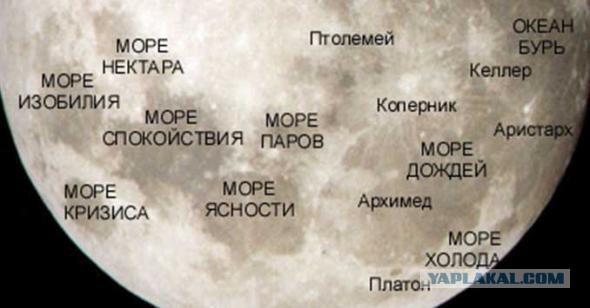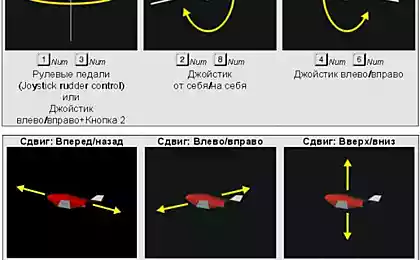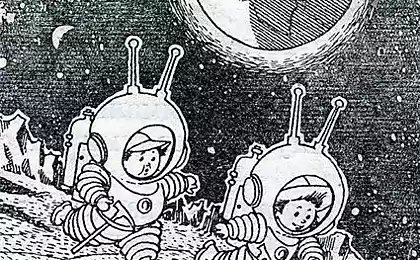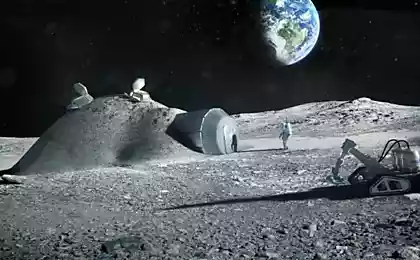855
Interesting facts about the moon.
One of the most fantastic theories about the origin of the moon has been put forward by two Soviet scientists Mikhail Vasin and Alexander Shcherbakov in the 60s. The essence of the theory is that the moon is nothing more than an artificial planetoid intentionally launched into orbit ...
6 photos.

As arguments led scientists that lunar craters have different diameters but has always a depth of not more than 3 kilometers. This fact is really the place to be and it is possible only if the loonie under the surface there is a very solid structure.
The theory has found indirect confirmation when November 20, 1969 the crew of the Apollo 12 lunar module thrown onto the surface of the moon, it hit the surface of the artificial moonquake provoked. The consequences were unexpected then the moon rang like a bell for another hour. It does the same team of Apollo 13, a special effort strike force. The results were simply amazing device recorded seismic vibrations moon duration: 3 hours and 20 minutes, and the radius of distribution (40 km). Thus, the researchers concluded that the moon has an unusually light nucleus, or perhaps not at all have a kernel.
As stated on the occasion of one of these experiments, Dr. Thomas Payne (then director of the NASA), "Luna was humming like a bell. We are not able to explain this phenomenon ... »
Seismometers installed by astronauts "Apollo" in the area of the crater Bulliald (south-eastern part of the visible disk of the moon), systematically transmit signals to Earth, as opposed to having a rare sporadic moonquakes some monotonous rhythm ...

A colleague George Leonard, Dr. Dan examining gathers this 37-mile crater and photographs, came to the conclusion - "Such rhythmic moonquakes may be caused by the passage of trains" lunar underground »...
On the moon there are concentrated mass of metal creates a gravitational and magnetic anomalies of the moon - "mascons." (According to the latest data, under the lunar surface there are five huge objects ranging in size from 8 to 22 kilometers. Some of them have been identified in the infrared range of European research satellite "COSMIC Lab" in 1999 - VK)

The Moon makes a complete orbit around the Earth for 27, 3 days. She always turned to one side of the Earth. Side of the Moon was not available to the human eye until 1959, when the Soviet spacecraft "Luna-3" photographed her.

powerful telescope, you can see more than 500,000 lunar craters. The biggest of them is called Bailly, its diameter is approximately 300 km., And the area slightly larger than the area of Scotland.

The dark spots visible to the naked eye on the lunar surface, called seas. They have no water, but millions of years ago, they were filled with volcanic lava. Some of them are very large, such as the Ocean of Storms over the Mediterranean Sea.

On the moon there is no air, no water. Its soil is so dry that it nothing can grow. However, the researchers found that in samples brought to Earth lunar soil plants can grow.
Unlike the Earth's surface is constantly changing waters by water and wind, lunar surface remains unchanged. Footprints left on the Moon by astronauts aboard the "Apollo" will be visible for at least 10 million years.
On the Moon occur earthquake called moonquake, but compared with the earth, they are very weak. Every year there are more than 3,000 moonquakes, but their total energy just be enough for a small fireworks display.
The average density of the moon is equal to 3.34 g / cm3, a conclusion derived from astronomical data shows that the interior of the moon - it is likely a hollow rather than a homogeneous sphere.
The orbit of the moon around the earth is an oval rather than a circle, so the distance from the center of the earth to the center of the moon is constantly varied.
With every second the moon is moving away from us, extending its orbit in the year by 4 cm. Scientists say that when the moon is only formed (4, 6 billion years ago), it was at a distance of 22,530 km from the earth. Now the distance is more than 450,000 km.
On the moon there is an echo. November 20, 1969 the crew of the Apollo 12 lunar module thrown onto the surface of the moon, and the noise of its impact on the lunar surface provoked an artificial earthquake. The consequences were unexpected then the moon rang like a bell for another hour.
The gravitational force of the Earth causes the Moon to revolve around the Earth. However, the attraction of the moon affects the Earth in the first place on the seas and oceans, causing the tides. When the Moon is on the near distance, its attraction is enhanced and the tides reach their highest level.
With only the knowledge gleaned from long ago lessons on astronomy in the Soviet school, in my view indisputable arguments in favor of artificial moons are:
1. Almost perfectly circular trajectory of the moon around the earth
2. In practice, the round shape of the moon
3. The perfect match of rotation of the moon around its axis and orbits around the earth in consequence of which we see only one side of the moon.
4. Perfect match the size of the moon with the size of the visible solar disk from the ground. For this reason, we see the so-called crown during a solar eclipse.
5. If the size and how far from the ground, the moon must have a very low density, but the depth of impact craters indicates relatively dense structure, which at such sizes of the moon would make it much harder, and thus the distance from the earth should have been more.
6. The magnetic anomalies are due?
7. moving luminous objects on the moon.
To date, the moon contains more puzzles than answers. It may be promised a lunar base, which likely will not be able to shed light on some of the questions.
source
6 photos.

As arguments led scientists that lunar craters have different diameters but has always a depth of not more than 3 kilometers. This fact is really the place to be and it is possible only if the loonie under the surface there is a very solid structure.
The theory has found indirect confirmation when November 20, 1969 the crew of the Apollo 12 lunar module thrown onto the surface of the moon, it hit the surface of the artificial moonquake provoked. The consequences were unexpected then the moon rang like a bell for another hour. It does the same team of Apollo 13, a special effort strike force. The results were simply amazing device recorded seismic vibrations moon duration: 3 hours and 20 minutes, and the radius of distribution (40 km). Thus, the researchers concluded that the moon has an unusually light nucleus, or perhaps not at all have a kernel.
As stated on the occasion of one of these experiments, Dr. Thomas Payne (then director of the NASA), "Luna was humming like a bell. We are not able to explain this phenomenon ... »
Seismometers installed by astronauts "Apollo" in the area of the crater Bulliald (south-eastern part of the visible disk of the moon), systematically transmit signals to Earth, as opposed to having a rare sporadic moonquakes some monotonous rhythm ...

A colleague George Leonard, Dr. Dan examining gathers this 37-mile crater and photographs, came to the conclusion - "Such rhythmic moonquakes may be caused by the passage of trains" lunar underground »...
On the moon there are concentrated mass of metal creates a gravitational and magnetic anomalies of the moon - "mascons." (According to the latest data, under the lunar surface there are five huge objects ranging in size from 8 to 22 kilometers. Some of them have been identified in the infrared range of European research satellite "COSMIC Lab" in 1999 - VK)

The Moon makes a complete orbit around the Earth for 27, 3 days. She always turned to one side of the Earth. Side of the Moon was not available to the human eye until 1959, when the Soviet spacecraft "Luna-3" photographed her.

powerful telescope, you can see more than 500,000 lunar craters. The biggest of them is called Bailly, its diameter is approximately 300 km., And the area slightly larger than the area of Scotland.

The dark spots visible to the naked eye on the lunar surface, called seas. They have no water, but millions of years ago, they were filled with volcanic lava. Some of them are very large, such as the Ocean of Storms over the Mediterranean Sea.

On the moon there is no air, no water. Its soil is so dry that it nothing can grow. However, the researchers found that in samples brought to Earth lunar soil plants can grow.
Unlike the Earth's surface is constantly changing waters by water and wind, lunar surface remains unchanged. Footprints left on the Moon by astronauts aboard the "Apollo" will be visible for at least 10 million years.
On the Moon occur earthquake called moonquake, but compared with the earth, they are very weak. Every year there are more than 3,000 moonquakes, but their total energy just be enough for a small fireworks display.
The average density of the moon is equal to 3.34 g / cm3, a conclusion derived from astronomical data shows that the interior of the moon - it is likely a hollow rather than a homogeneous sphere.
The orbit of the moon around the earth is an oval rather than a circle, so the distance from the center of the earth to the center of the moon is constantly varied.
With every second the moon is moving away from us, extending its orbit in the year by 4 cm. Scientists say that when the moon is only formed (4, 6 billion years ago), it was at a distance of 22,530 km from the earth. Now the distance is more than 450,000 km.
On the moon there is an echo. November 20, 1969 the crew of the Apollo 12 lunar module thrown onto the surface of the moon, and the noise of its impact on the lunar surface provoked an artificial earthquake. The consequences were unexpected then the moon rang like a bell for another hour.
The gravitational force of the Earth causes the Moon to revolve around the Earth. However, the attraction of the moon affects the Earth in the first place on the seas and oceans, causing the tides. When the Moon is on the near distance, its attraction is enhanced and the tides reach their highest level.
With only the knowledge gleaned from long ago lessons on astronomy in the Soviet school, in my view indisputable arguments in favor of artificial moons are:
1. Almost perfectly circular trajectory of the moon around the earth
2. In practice, the round shape of the moon
3. The perfect match of rotation of the moon around its axis and orbits around the earth in consequence of which we see only one side of the moon.
4. Perfect match the size of the moon with the size of the visible solar disk from the ground. For this reason, we see the so-called crown during a solar eclipse.
5. If the size and how far from the ground, the moon must have a very low density, but the depth of impact craters indicates relatively dense structure, which at such sizes of the moon would make it much harder, and thus the distance from the earth should have been more.
6. The magnetic anomalies are due?
7. moving luminous objects on the moon.
To date, the moon contains more puzzles than answers. It may be promised a lunar base, which likely will not be able to shed light on some of the questions.
source























